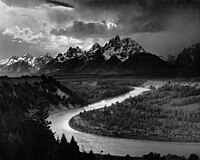
Photo from wikipedia
Thermal refuges form important habitat for cold-water fishes in the face of rising temperatures. As fish become concentrated in refuges, food resources may become depleted. In this study, we used… Click to show full abstract
Thermal refuges form important habitat for cold-water fishes in the face of rising temperatures. As fish become concentrated in refuges, food resources may become depleted. In this study, we used invertebrate drift sampling and fish density surveys to quantify potential in-refuge food limitation, temperature-sensitive radio-tagging studies to quantify thermal habitat use, and isotopic analyses to determine diet sources for juvenile Pacific salmonids using thermal refuges in California’s Klamath River. Juvenile salmonids using refuges formed by tributary junctions with the mainstem river obtained the majority (range = 47%–97%) of their diet from mainstem prey sources. Mean steelhead (Oncorhynchus mykiss) body temperatures were significantly cooler (∼3.5 °C) than diet-inferred foraging temperatures. Thus, while fish seek cooler habitat for physiological benefits, they rely primarily on mainstem prey. Moreover, consistently high densities of fish in refuges (mean = 3.5 fish·m−2) could lead to density-depende...
Journal Title: Canadian Journal of Fisheries and Aquatic Sciences
Year Published: 2017
Link to full text (if available)
Share on Social Media: Sign Up to like & get
recommendations!